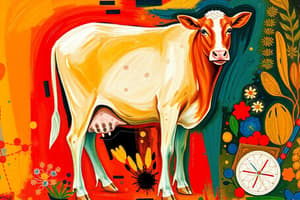Podcast
Questions and Answers
What are the two primary types of carbohydrates found in animal feeds, and what is their significance?
What are the two primary types of carbohydrates found in animal feeds, and what is their significance?
The two primary types are starch and fiber. They provide energy and facilitate digestion in animals.
Describe the structural components of triglycerides and their importance in animal nutrition.
Describe the structural components of triglycerides and their importance in animal nutrition.
Triglycerides consist of a glycerol backbone and three fatty acids. They are essential for providing energy and supporting cellular functions.
Explain the role of essential amino acids in animal diets and provide two examples.
Explain the role of essential amino acids in animal diets and provide two examples.
Essential amino acids must be obtained from the diet; examples include arginine and histidine. They are crucial for protein synthesis and overall health.
What is the primary function of lipase in the digestion of fats?
What is the primary function of lipase in the digestion of fats?
What happens to excess ammonia produced during protein metabolism in animals?
What happens to excess ammonia produced during protein metabolism in animals?
Discuss the significance of whole grain cereals in animal feeds regarding their carbohydrate content.
Discuss the significance of whole grain cereals in animal feeds regarding their carbohydrate content.
How does lignin impact the digestibility of other dietary components in animal feeds?
How does lignin impact the digestibility of other dietary components in animal feeds?
Differentiate between simple and mixed triglycerides in terms of their composition.
Differentiate between simple and mixed triglycerides in terms of their composition.
Describe the role of bile in fat digestion and its overall importance.
Describe the role of bile in fat digestion and its overall importance.
Explain the significance of the partitioning of feed energy in ruminants.
Explain the significance of the partitioning of feed energy in ruminants.
What are essential amino acids and how are they obtained?
What are essential amino acids and how are they obtained?
What is the consequence of lignin in animal diets?
What is the consequence of lignin in animal diets?
What is the primary role of bile in fat digestion?
What is the primary role of bile in fat digestion?
What is digestible energy (DE) and its relevance in feeding practices?
What is digestible energy (DE) and its relevance in feeding practices?
What is the significance of starch in animal feeds derived from whole grain cereals?
What is the significance of starch in animal feeds derived from whole grain cereals?
How do simple triglycerides differ from mixed triglycerides?
How do simple triglycerides differ from mixed triglycerides?
What happens to excess ammonia that is produced during protein metabolism?
What happens to excess ammonia that is produced during protein metabolism?
What is the primary function of lipase in fat digestion?
What is the primary function of lipase in fat digestion?
What does the partitioning of feed energy in ruminants help to understand?
What does the partitioning of feed energy in ruminants help to understand?
Flashcards are hidden until you start studying
Study Notes
Carbohydrates in Animal Feeds
- Two primary types of carbohydrates: starch and fiber.
- Whole grain cereals are rich in starch, primarily in amylose and amylopectin forms.
Triglycerides Structure
- Composed of a glycerol backbone linked to three fatty acids.
- Simple triglycerides have three identical fatty acids, while mixed triglycerides contain different types.
Essential Amino Acids
- Essential amino acids must be acquired through diet.
- Examples include arginine and histidine.
Lipase Function
- Lipase plays a crucial role in fat digestion by breaking down fatty acids for absorption.
Ammonia in Protein Metabolism
- Excess ammonia produced during protein metabolism is converted to urea for excretion in urine.
- Consequences of elevated ammonia include potential toxicity if not converted effectively.
Role of Lignin
- Lignin is completely indigestible, which negatively affects the digestibility of other dietary components, particularly fiber and protein.
Bile's Role in Fat Digestion
- Bile activates pancreatic lipase, essential for emulsifying fats, which reduces their size for easier digestion.
Energy Partitioning in Ruminants
- Understanding the partitioning of feed energy is vital for optimizing diets by identifying usable energy versus losses.
Importance of Digestible Energy (DE)
- Digestible energy (DE) refers to the portion of feed energy absorbed and available for use, excluding energy lost in feces.
Carbohydrates in Animal Feeds
- Two primary types of carbohydrates: starch and fiber.
- Whole grain cereals are significant sources of starch, majorly as amylose and amylopectin.
Triglycerides Structure
- Composed of a glycerol backbone linked to three fatty acids.
- Simple triglycerides have three identical fatty acids, while mixed triglycerides contain different fatty acids.
Essential Amino Acids
- Essential amino acids must be acquired through diet as the body cannot synthesize them.
- Examples include arginine and histidine.
Role of Lipase
- Lipase is responsible for breaking down fatty acids, facilitating their absorption during fat digestion.
Ammonia Metabolism
- Excess ammonia produced from protein metabolism is converted into urea.
- Urea is then excreted in urine to manage ammonia toxicity.
Impact of Lignin
- Lignin is indigestible and reduces the digestibility of dietary components, especially fiber and protein.
Bile in Fat Digestion
- Bile activates pancreatic lipase, aiding in the emulsification of fats.
- Emulsification breaks fats into smaller particles, enhancing digestibility.
Energy Partitioning in Ruminants
- Understanding how feed energy is partitioned helps optimize diets for ruminants, distinguishing utilized energy from losses.
Digestible Energy (DE)
- Digestible energy refers to the portion of feed energy absorbed and utilized by the animal.
- It excludes energy lost in feces and is crucial for assessing the nutritional value of feeds.
Studying That Suits You
Use AI to generate personalized quizzes and flashcards to suit your learning preferences.




